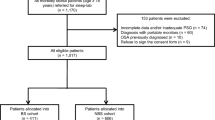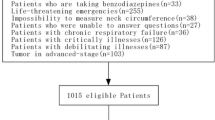Abstract
Background
The loud Snoring, Tiredness, Observed apnea, high blood Pressure (STOP)-Body mass index (BMI), Age, Neck circumference, and gender (Bang) questionnaire is a validated screening tool for identifying obstructive sleep apnea in surgical patients. However, the predictive performance of the STOP-Bang score in obese and morbidly obese patients remains unknown.
Methods
Preoperative patients were approached for consent and were screened for obstructive sleep apnea (OSA) by the STOP questionnaire. Information concerning Bang was collected. Laboratory or portable polysomnography were performed in 667 patients. Patients with BMI of ≥30 kg/m2 were defined as obese patients and ≥35 kg/m2 as morbidly obese. The predictive parameters (sensitivity, specificity, and positive and negative predictive values) for the STOP-Bang score in obese and morbidly obese patients were analyzed.
Results
In 310 obese patients, a STOP-Bang score of 3 has high sensitivity of 90 % and high positive predictive value of 85 % for identifying obese patient with OSA. A STOP-Bang score of 4 had high sensitivity (87.5 %) and high negative predictive value (90.5 %) for identifying severe OSA, whereas a STOP-Bang score of 6 had high specificity (85.2 %) to identify severe OSA. The diagnostic odds ratio of a STOP-Bang score of 4 was 4.9 for identifying severe OSA. In 140 morbidly obese patients, a STOP-Bang score of 4 had high sensitivity (89.5 %) for identifying severe OSA.
Conclusions
The STOP-Bang score was validated in the obese and morbidly obese surgical patients. For identifying severe OSA, a STOP-Bang score of 4 has high sensitivity of 88 %. For confirming severe OSA, a score of 6 is more specific.






Similar content being viewed by others
Abbreviations
- OSA:
-
Obstructive sleep apnea
- AHI:
-
Apnea–Hypopnea Index
- PSG:
-
Polysomnography
- BMI:
-
Body mass index
- PPV:
-
Positive predictive value
- NPV:
-
Negative predictive value
References
Young T, Hutton R, Finn L, et al. The gender bias in sleep apnea diagnosis. Are women missed because they have different symptoms? Arch Intern Med. 1996;156:2445–51.
Marshall NS, Wong KK, Liu PY, et al. Sleep apnea as an independent risk factor for all-cause mortality: the Busselton Health Study. Sleep. 2008;31:1079–85.
Young T, Finn L, Peppard PE, et al. Sleep disordered breathing and mortality: eighteen-year follow-up of the Wisconsin Sleep Cohort. Sleep. 2008;31:1071–8.
Kaw R, Chung F, Pasupuleti V, et al. Meta-analysis of the association between obstructive sleep apnoea and postoperative outcome. Br J Anaesth. 2012;109:897–906.
Liao P, Yegneswaran B, Vairavanathan S, et al. Postoperative complications in patients with obstructive sleep apnea: a retrospective matched cohort study. Can J Anesth. 2009;56:819–28.
Memtsoudis S, Liu SS, Ma Y, et al. Perioperative pulmonary outcomes in patients with sleep apnea after noncardiac surgery. Anesth Analg. 2011;112:113–21.
Young T, Evans L, Finn L, et al. Estimation of the clinically diagnosed proportion of sleep apnea syndrome in middle-aged men and women. Sleep. 1997;20:705–6.
Chung F, Yegneswaran B, Liao P, et al. Validation of Berlin Questionnaire and ASA Checklist as screening tools for obstructive sleep apnea in surgical patients. Anesthesiology. 2008;108:822–30.
Finkel KJ, Searleman AC, Tymkew H, et al. Prevalence of undiagnosed obstructive sleep apnea among adult surgical patients in an academic medical center. Sleep Med. 2009;10:753–8.
World Health Organization. Obesity and overweighed fact sheet No 311. May 2012. (http://www.who.int/mediacentre/factsheets/fs311/en/index.html).
Young T, Palta M, Dempsey J, et al. The occurrence of sleep-disordered breathing among middle-aged adults. N Engl J Med. 1993;328:1230–5.
Young T, Peppard PE, Gottlieb DJ. Epidemiology of obstructive sleep apnea: a population health perspective. Am J Respir Crit Care Med. 2002;165:1217–39.
Frey WC, Pilcher J. Obstructive sleep-related breathing disorders in patients evaluated for bariatric surgery. Obes Surg. 2003;13:676–83.
Malhotra A, White DP. Obstructive sleep apnoea. Lancet. 2002;360:237–45.
Vgontzas AN, Tan TL, Bixler EO, et al. Sleep apnea and sleep disruption in obese patients. Arch Intern Med. 1994;154:1705–11.
Chung F, Yegneswaran B, Liao P, et al. STOP Questionnaire: a tool to screen obstructive sleep apnea. Anesthesiology. 2008;108:812–21.
Chung F, Subramanyam R, Liao P, et al. High STOP-Bang score indicates a high probability of obstructive sleep apnoea. Br J Anaesth. 2012;108:768–75.
Corso RM, Piraccini E, Agnoletti V, et al. Clinical use of the STOP-BANG questionnaire in patients undergoing sedation for endoscopic procedures. Minerva Anestesiol. 2012;78:109–10.
Dias RA, Hardin KA, Rose H, et al. Sleepiness, fatigue, and risk of obstructive sleep apnea using the STOP-BANG questionnaire in multiple sclerosis: a pilot study. Sleep Breath. 2012;16:1255–65.
Kurrek MM, Cobourn C, Wojtasik Z, et al. Morbidity in patients with or at high risk for obstructive sleep apnea after ambulatory laparoscopic gastric banding. Obes Surg. 2011;21:1494–8.
McCormack DJ, Pabla R, Babu MH, et al. Undiagnosed sleep apnoea syndrome in patients with acute myocardial infarction: potential importance of the STOP-BANG screening tool for clinical practice. Int J Cardiol. 2012;155:342–3.
Sleep-related breathing disorders in adults: recommendations for syndrome definition and measurement techniques in clinical research. The Report of an American Academy of Sleep Medicine Task Force. Sleep. 1999;22:667–89.
Chung F, Liao P, Sun Y, et al. Perioperative practical experiences in using a level 2 portable polysomnography. Sleep Breath. 2010;15:367–75.
Practice parameters for the use of portable recording in the assessment of obstructive sleep apnea. Standards of Practice Committee of the American Sleep Disorders Association. Sleep. 1994;17:372–7.
Iber C, Ancoli-israel S, Cheeson A, et al. The AASM manual for the scoring of sleep and associated events, rules, terminology and technical specifications. Westchester, IL, USA: American Academy of Sleep Medicine; 2007.
Obuchowski NA. Sample size calculations in studies of test accuracy. Stat Methods Med Res. 1998;7:371–92.
Sareli AE, Cantor CR, Williams NN, et al. Obstructive sleep apnea in patients undergoing bariatric surgery—a tertiary center experience. Obes Surg. 2011;21:316–27.
Ray P, Le MY, Riou B, et al. Statistical evaluation of a biomarker. Anesthesiology. 2010;112:1023–40.
Farney RJ, Walker BS, Farney RM, et al. The STOP-Bang equivalent model and prediction of severity of obstructive sleep apnea: relation to polysomnographic measurements of the Apnea/Hypopnea Index. J Clin Sleep Med. 2011;7:459–65.
Peppard PE, Young T, Palta M, et al. Longitudinal study of moderate weight change and sleep-disordered breathing. JAMA. 2000;284:3015–21.
Martinez-Rivera C, Abad J, Fiz JA, et al. Usefulness of truncal obesity indices as predictive factors for obstructive sleep apnea syndrome. Obesity. 2008;16:113–8.
Heinzer RC, Stanchina ML, Malhotra A, et al. Effect of increased lung volume on sleep disordered breathing in patients with sleep apnoea. Thorax. 2006;61:435–9.
Jordan AS, White DP, Owens RL, et al. The effect of increased genioglossus activity and end-expiratory lung volume on pharyngeal collapse. J Appl Physiol. 2010;109:469–75.
Schwartz AR, Patil SP, Squier S, et al. Obesity and upper airway control during sleep. J Appl Physiol. 2010;108:430–5.
Carneiro G, Florio RT, Zanella MT, et al. Is mandatory screening for obstructive sleep apnea with polysomnography in all severely obese patients indicated? Sleep Breath. 2012;16:163–8.
Daltro C, Gregorio PB, Alves E, et al. Prevalence and severity of sleep apnea in a group of morbidly obese patients. Obes Surg. 2007;17:809–14.
Acknowledgments
We acknowledge the help of Santhira Vairavanathan MBBS (Research Coordinator, Department of Anesthesia, University Health Network, Toronto, Ontario, Canada), Sazzadul Islam MSc (Research Coordinator, Department of Anesthesia, University Health Network, Toronto, Ontario, Canada), Hisham Elsaid, M.D. (Research Fellow, Department of Anesthesia, University Health Network, Toronto, Ontario, Canada), Babak Amirshahi MD (Research Fellow, Department of Anesthesia, University Health Network, Toronto, Ontario, Canada), and Hoda Fazel, M.D. (Research Fellow, Department of Anesthesia, University Health Network, Toronto, Ontario, Canada) in the conduct of the study. We also acknowledge Yuming Sun, M.D. (Registered Polysomnographic Technologist, Sleep Research Unit & Department of Anesthesia, University Health Network, Toronto, Ontario, Canada) for the readings of the polysomnography and Colin Shapiro, M.D. (Professor, Department of Psychiatry; Director, Sleep Research Unit, Toronto Western Hospital, University Health Network, University of Toronto) for the polysomnography supervision.
Department/institution to which the work is attributed
Department of Anesthesiology and Pain Management, Toronto Western Hospital, University Health Network, University of Toronto
Sources of financial support for the work
Physicians Services Incorporated Foundation, University Health Network Foundation, and Department of Anesthesia, University Health Network-Mount Sinai Hospital, University of Toronto, Toronto, Ontario, Canada
Author information
Authors and Affiliations
Corresponding author
Rights and permissions
About this article
Cite this article
Chung, F., Yang, Y. & Liao, P. Predictive Performance of the STOP-Bang Score for Identifying Obstructive Sleep Apnea in Obese Patients. OBES SURG 23, 2050–2057 (2013). https://doi.org/10.1007/s11695-013-1006-z
Published:
Issue Date:
DOI: https://doi.org/10.1007/s11695-013-1006-z




